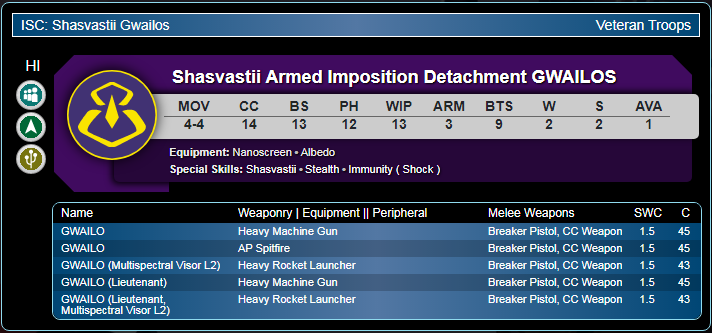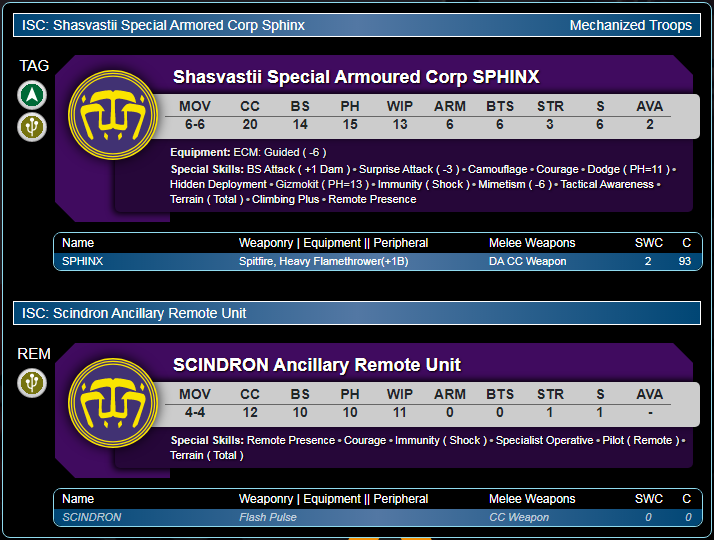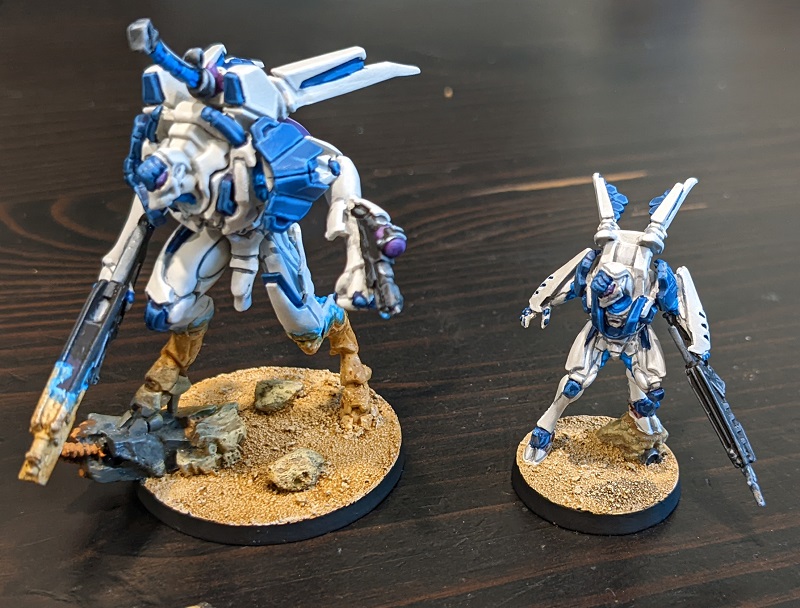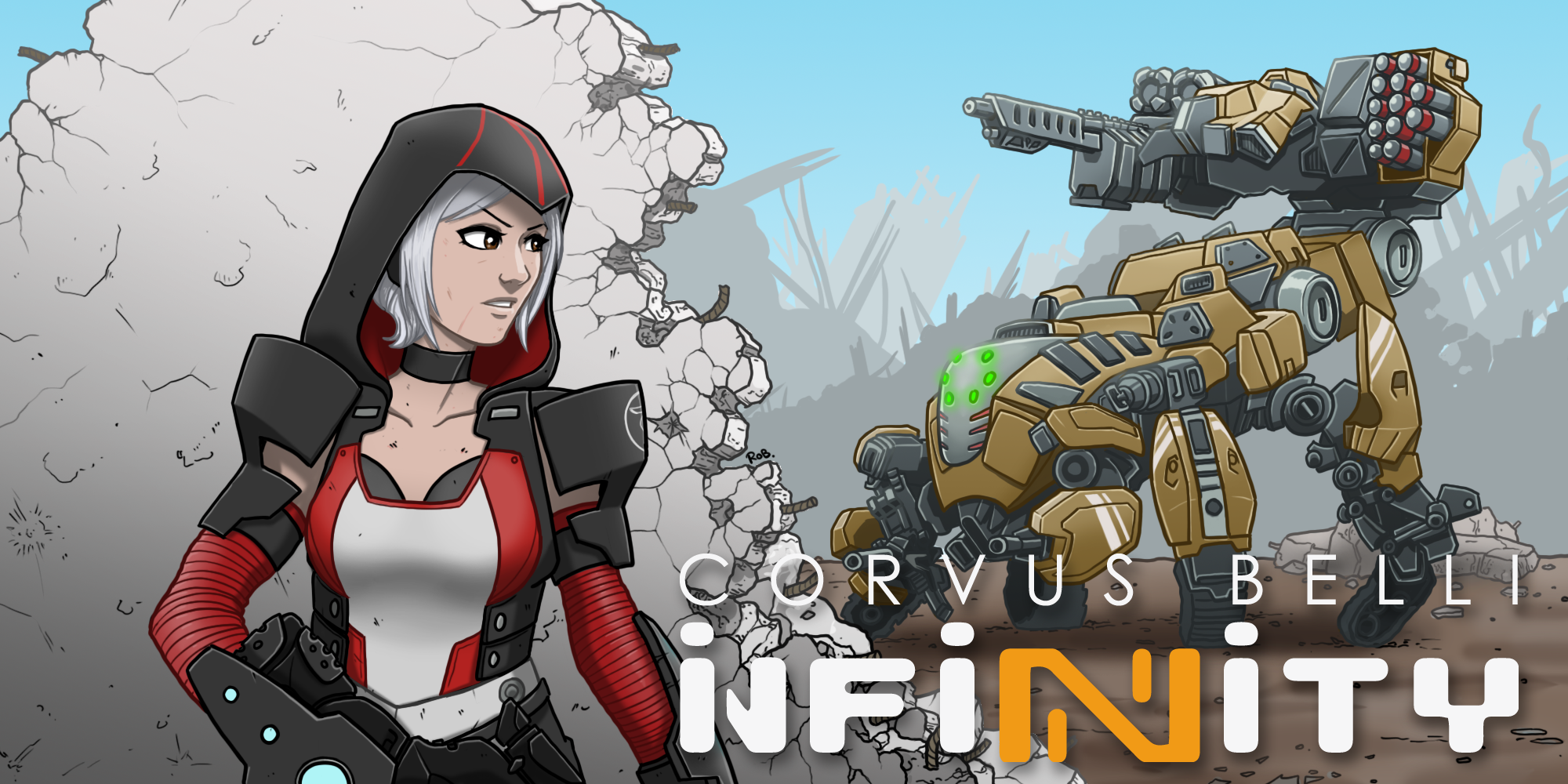The preparation for the ITS After Dark event at GenCon continues, this time taking a look at two of the heaviest hitters for the Shasvastii Expeditionary Force: the Gwailo heavy infantry and the fearsome Sphinx TAG.
Right, so when I first started this hare-brained idea, I had a grand total of roughly 95 points and 0.5 SWC of Shasvastii painted. That put me less than a quarter of the way towards my goal of 400 points painted and ready for the tournament. Realistically, I’ll probably need more because it is customary to make two different army lists (both of the same faction/sectorial, of course) for an ITS event, only choosing which force you will field after you know the mission, the opponent, and any Classified Objectives in play. Depending on how all this works out, I may not have the luxury of lists that are radically different. And even after finishing Dr. Worm and his assistants last week, I’m still only at around 123 points.
So I need to get some points painted, and quickly! The easiest way to do that is to tackle the expensive stuff first, and of the miniatures I have available that means the Gwailo and the Sphinx.
The Devil Man
Often translated into English as “foreign devil,” in Cantonese the term “gwailou” is a word formed from gwai (meaning “devil” or “ghost”) and lou (meaning “man” or “person”). In common slang, it is most frequently used as a derogatory term for white people. In the backstory fluff of Infinity, the Gwailo is so named because the first human forces to encounter it were the troopers of the Yu Jing faction, and it was found to be simultaneously sneaky, destructive, and often invisible to advanced multi-spectral sensors. An alien devil indeed.
In Infinity parlance, the Gwailo is Heavy Infantry, although the term “heavy” is doing some heavy lifting here – the Gwailo is only as armored as a USAriadna Grunt that costs less than a quarter the Gwailo’s points. But like virtually all other HI in the game, the Gwailo has two wounds and is immune to the effects of Shock ammunition (which normally bypasses the “Unconscious” state and sends its victim straight to being dead), giving it a bit more resilience.

Though not particularly beefy (most Shasvastii troops are somewhat fragile in comparison to other factions’ units of similar type), the Gwailo has much to recommend it. First and foremost, it comes equipped standard with a Nanoscreen and Albedo.
Nanoscreen
One of the nuances of the ARO mechanic in Infinity is that when declaring a reaction against an enemy trooper, you can do so at any point during that enemy trooper’s movement. That means that even if your trooper starts in cover at the beginning of his move and finishes in cover at the end of his move, if at any point in between he was not touching a piece of terrain that obscured him from the enemy, he cannot claim the benefit of cover. Generally, this means that in order to advance or move, you are in all likelihood going to present your opponent with an opportunity to deprive you of cover.
The Nanoscreen is the answer to this conundrum. This fun bit of kit means the trooper is equipped with a thick cloud of obscuring nano-particles, carrying around its own partial cover wherever it goes. Thus, because the Nanoscreen is always active, the trooper equipped with it can claim partial cover even while in the open, which in turn means that you can claim partial cover even on the move. Even better, this is a 360-degree effect, meaning that is impossible to sneak around behind the nanoscreened trooper to deprive it of cover. Partial cover in Infinity provides a -3 modifier to an opponent’s roll(s) to hit, and gives a +3 bonus to the trooper’s Armor when resisting any rounds that do hit, which in the case of the Gwailo goes some way towards offsetting the unit’s relatively weak natural ARM value.
This ability to claim cover while moving allows the Gwailo to be used very aggressively, without the player having to worry about tiptoeing about trying to keep from getting popped while not cozied up to a wall or barrier. It being treated as partial cover, however, means that things which ignore partial cover entirely (such as Direct Template Weapons and troopers with the Marksman skill) can still pose a danger.
Albedo
The Shasvastii rely heavily on camouflage and trickery, with many of their troops imposing a negative visibility modifier (Mimetism -3 or -6) or being able to deploy and move in the Camouflage state (i.e. represented on the table as a marker rather than as a model until they reveal themselves or are discovered). The counter to this is the Multi-Spectral Visor, which comes in several levels and allows the user to reduce or even eliminate the visibility penalties for Mimetism (which ordinarily apply to rolls to both discover the trooper and then shoot them once they are revealed). Troops equipped with MSV can also see through smoke or other forms of obscuration, making them very dangerous foes.
Albedo is the counter to the counter – it imposes visibility modifiers that only affect troops equipped with MSV, rendering them completely blind to the trooper equipped with this gear. Albedo is of limited use, however, only being effective in the first turn of the game (an Infinity tournament game is almost always 3 turns, which doesn’t sound like much but a lot can happen in those turns!).
The combination of Nanoscreen and Albedo makes the Gwailo frighteningly good at taking out one of the most common (because it is so effective) ARO pieces in the game – the MSV2 sniper. Virtually all armies in Infinity have some form of trooper that can be equipped with level-2 MSV (which makes ordinary smoke transparent and negates even Mimetism -6), and most of those troopers have a profile that has some form of sniper rifle. Worse, most sectorials have the ability to put such a trooper into a fireteam to take advantage of +1 Burst or even bonuses to their hit rolls. The +1 Burst bonus from fireteams applies in ARO, which is one of the things that makes these troopers so potent. Linked MSV2 snipers are an auto-take in many peoples’ lists, and having an Albedo-equipped trooper can offer a very valuable tool for countering this common strategy.
Profiles
Built to run hard, the Gwailo is going to be carrying some form of heavy weapon, either an HMG, a Spitfire (think like a Squad Automatic Weapon, same rate of fire as an HMG but at a shorter range) kitted out with armor piercing rounds, or a Heavy Rocket Launcher (which fires incendiary ammunition). All of these are fun toys, and which one you choose largely depends on what mission role you hope to have the Gwailo fill and whether you can spare the 2 extra points needed for the HMG or AP Spitfire. The HMG is good for stand-off firefights, where you are engaging at a decent range. The AP Spitfire is a more aggressive choice, and will be better used in the mid-field (and where getting into the Suppressive Fire state is more advantageous). And The HRL’s “continuous damage” trait means it has a chance to take out resilient units with multiple wounds or skills like Dogged or No Wound Incapacitation in a single hit.
In the context of taking on MSV2 snipers, both the HMG and the HRL offer good range bands that get bonuses at the kinds of ranges from which snipers tend to operate. The high Burst value of the HMG gives you more chances to hit, but in the first active turn the HRL being a template weapon means the blind MSV2 sniper is dodging at a -3 modifier, and when taking out those assholes every little bit helps (because if you don’t kill him in the first volley, he’s probably going to go prone and drop out of sight). And if he’s linked, you might just catch some of his buddies under the template.
Two other facets of the Gwailo bear mentioning; the beefy 9 BTS helps make this hackable HI more resilient to Comms Attacks, and Stealth means that even if someone manages to get your Gwailo into repeater coverage, you can walk out of it in your active turn without triggering hacking AROs (so long as you opponent’s hacker doesn’t benefit from Sixth Sense, that is). This may not seem like a big deal, but it the right situation it can mean the difference between being combat effective or being Isolated and Immobilized by enemy hackers.
It’s also worth noting that the Gwailo has Lieutenant profiles. If you’re the kind of crazy madman who likes to run an aggressive, heavy-hitting Lt, the Gwailo might just be what you’re looking for. That said, given that the Gwailo is almost purpose-built to tangle with linked snipers, I’m always a bit leery of packing so many eggs into one basket, as it only takes two bad trades to leave you in Loss of Lieutenant.
Finished Model
I had already base-coated my Gwailo and done the little bit of exposed flesh on his legs and the lighter blue “skinsuit” under his armor. Finishing him off required lining the gaps between armor panels with VMC Light Gray and edge highlighting the armor panels with VMC White. The dark blue accent panels came next, and these are my favorite part of the process. This is the point at which the whole thing goes from, “I’m not so sure…” to “Hell yeah!”
Riddle Me This…
The Sphinx is one of the trademark units of the Shasvastii Expeditionary Force. It is one of only two TAGs in the game that benefit from Hidden Deployment (the other being the Varuna Cutter of PanO), meaning that if you choose to, you don’t even have to put the model on the table. It’s also lousy with additional special rules, the most important of which are Camouflage, Mimetism -6, and Climbing Plus.

As soon as you plunk a Silhouette 6 camo token down on the board your opponent is going to know what it represents, but it doesn’t change the fact that they still have to successfully Discover it to engage it with direct fire. And with Mimetism -6, a successful Discover roll may be a dicey proposition, especially if the Sphinx is also in cover (a -9 total modifier). Finally, while TAGs are generally really good at bullying their way over terrain (in Infinity you can freely “vault” over any object shorter than the height of your Silhouette), the addition of Climbing Plus means this giant, stompy robot treats vertical surfaces as horizontal for the purposes of movement. Normally, Climb is an Entire Order skill, but the Sphinx treats it as a Short Skill, meaning it can clamber up the side of a building and still take the opportunity to unload on you with its heavy flamethrower. Sorry, it’s 2 Burst heavy flamethrower, which allows it to place two templates down when it fires in the active turn. Fwoooosh! Opponent have a bunch of prone troopers on a roof behind a parapet and out of line of fire? You know what to do.
Further, with a 6-6 move the Sphinx is also one of the fastest TAGs in the game. The lack of any kind of Infiltration or Forward Deployment skill means you’re always going to be coming out of your own deployment zone, but it’s generally not going to take you many orders to get where you want to be.
And where you want to be is in the midfield, probably in cover and in the Suppressive Fire state. That stacks a whopping -12 modifier on your opponent before range bands are figured in, which can make knocking you out of Suppressive Fire extremely challenging (especially with a Burst value of 3 in ARO). Depending on the terrain layout on the table, the Sphinx can completely lock down an approach lane or be a fantastic objective camper. Absolutely need to keep your opponent off your beacon in the Capture and Protect mission? A Sphinx in Hidden Deployment can be an extremely nasty surprise for any enemy trooper who does make it close enough to grab your goodies.
That said, Hidden Deployment is a double-edged sword here. The problem stems from the order-of-operations for how each player’s turn progresses. Your orders are counted at the very beginning of your turn in the Tactical Phase, and while troopers in Hidden Deployment retain their own Regular Order to use to “enter” the table, any Irregular Order stemming from Tactical Awareness does not (because the trooper needs to be on the table during the Tactical Phase to benefit from this order). As such, if your Sphinx is still in Hidden Deployment at the beginning of your first turn, you are effectively losing an order.
This makes Hidden Deployment more potent for the player who goes second, especially if they can put their HD trooper in a place where the enemy is likely to provoke an ARO that allows the player to reveal that trooper before the beginning of their first turn. But then again, NOT revealing your trooper has merit too, as they cannot be targeted at all absent the enemy successfully using a Sensor to force its revelation. There’s something to be said for keeping a powerful piece in reserve until the last possible moment, especially in missions where points in zones are important.
Finished Model
Given the fact that the Sphinx can use Hidden Deployment, I wanted to capture its sneakiness on the mini itself. I know that the “decloaking” effect on miniatures is considered passe at this point, but I’d never done it and wanted to give it a go. With the bulk of the model being white, I needed to be super careful about how I blended things, and ended up going with a light blue energy/sparkle effect to make the transition easier. Using the same color pallet as the base, I stippled the shade and highlight colors on to the flat panels before giving everything a light wash in Seraphim Sepia. I was actually surprised at how well it worked, and at how well the feet blend into the base. Even the transition to the darker concrete color of the broken pillar worked pretty well. Of course photos always show you those areas where you screwed up, but on the whole I was extremely happy with how the effect turned out.
The only difficulty I have now is how to transport it. This thing is somehow simultaneously both spindly and chonky, and doesn’t fit in any of my existing Infinity transport stuff. But whatever, that’s a problem for future me to sort out.
Profiles
The Sphinx has one profile, so there’s no riddle to be unraveled here. The Spitfire and double Heavy Flamethrower are both nasty, if somewhat short ranged. And while you probably don’t want to get it into close combat with a dedicated melee trooper, the fact that it is armed with a Double-Action close-combat weapon (which innately has the “anti-materiel” trait) means there are some objectives that it can complete (like destroying warming units in Frostbyte). Similarly, the tiny, deployable Scindron mini-remote has the Specialist Operative trait, so it can scuttle out and push buttons if it absolutely needs to.
Put simply, in addition to eating up a ton of points that will help me get to my goal of 400, the Sphinx is a fantastic toolbox that will actually help me accomplish a bunch of my mission objectives. Now let’s look at how.
ITS Overview
If you’re not familiar with the Infinity Tournament System (ITS), each official tournament event draws its mission selection from a series of 20 missions, each with its own deployment zones, mission objectives, and special rules. These missions change a little bit each season, and each season of ITS missions usually has some theme that applies additional special rules. This year (Season 13) the theme is “Frozen Roads,” with the missions ostensibly taking place across Helheim, the frozen, antarctic continent on the human system of Concilium Prima as the forces of the Human Sphere struggle to deal with a new incursion by the hated Combined Army (and maybe take a break from fighting aliens now and again to settle some old grudges between each other in the process). The special rules are all about blizzard conditions, dealing with the cold, and crazy people who race motorcycles on the ice.
Frostbyte
One of the missions I’ll be playing in the ITS After Dark event is called “Frostbyte,” and it’s a new mission this year. It’s one of the more complicated missions, with tons of special rules, but essentially it’s a game that combines annihilation (where players get objective points for killing more army points’ worth of the enemy than vice versa) and zone control (where each player gets objective points by having more army points’ worth of troops in a particular region of the board), but with an additional twist that the players can alternately make certain zones of the board variably safe/lethal during the course of play.
The big problem for me in this game is the “exclusion zone” in the middle of the table. It’s ultimately where you want your troops to be, but it prevents the use of any Infiltration, Forward Deployment, or Airborne Deployment skills – and that’s what the Shasvastii are good at!
Additionally, both players’ deployment zones and each of the “dead zones” between those and the exclusion area in the middle of the board has a “heating unit,” which starts the game in an inactive state. At the end of the game, any unit in a zone with an active heating unit is safe. But any unit that is not immune to cold – i.e. a TAG, Heavy Infantry, Remote, or special “Snow-Ops” trooper (of which each player designates one from their force at the beginning of the game) – that is in a zone with an inactive heating unit just straight up dies at the end of the game (contributing its army points to the opponent). Heating units can be activated through the use of the consoles set up along the centerline of the board. Each console can only be used to activate one particular heating unit (the player decides which when they successfully use a console), but importantly cannot be used to deactivate a heating unit.

The first thing to note is that there are four heating units, but only three consoles with which to activate them. That means that someone is going to get screwed and end up with a zone on their side of the table in which all vulnerable units are going to die at the end of the game. And that’s even before people start schwacking their opponent’s heating units (yes, they can be attacked). The second thing to note is that there is no heating unit for the exclusion zone itself, which means that only the troop types immune to cold can survive there to score for zone domination at the end of the game.
Thus, the goal is simple: activate your own heating units, prevent the enemy from doing the same, then watch them freeze to death. Easy, right?
For this mission, the Sphinx and the Gwailo allow me to put a ton of points – probably 136 if I end up using the HRL profile for the Gwailo – into the exclusion zone. If I get the first turn and think I can get into a position to camp a couple of the consoles with the Sphinx, I’ll just deploy it in marker state, move it into a good spot, drop it into Suppressive Fire, and force my opponent to chew through orders trying to shift it. If I lose first turn advantage, it might be worth fighting the majority of the game short-handed and leaving the Sphinx in Hidden Deployment until my final turn, then revealing it and having it dash into the exclusion zone at the very end of the game – hopefully tipping the balance in the zone domination objective. This puts a huge chunk of my points into a pretty “safe” place until I need them.
For the Gwailo, I think getting into the zone and hunkering down is what I’ll likely need to do. It’s tough for a Shasvastii unit, but not super durable objectively speaking. It’s a lot of points, though, and it has an ace up its sleeve – the “Shasvastii” special skill. You see, in Infinity’s fluff, the Shasvastii once suffered a near-extinction level event, and ever since they have become super paranoid about getting wiped out, to the point that no Shasvastii leaves home with a “spawn embryo” it can leave somewhere to ensure the propagation of the species. In game terms, units with this rule (which includes most Shasvastii but not units like Dr. Worm or the Shinx) still have their points count towards zone domination even if when unconscious. Turns out they’re only horror-movie dead, not really dead. Thus, putting my Gwailo somewhere that it can drop out of line-of-fire if it goes unconscious may be the difference.
Either way, I now have roughly 260/400 points painted. Sadly, these are the biggest chunks I’m going to be able to take off in one go, so from here on out it’s going to be more of a slog.

Next Time:
“Oh look, it’s Karen! From the Sales Department! Why do you suppose she has that giant sword?”
Have any questions or feedback? Drop us a note in the comments below or email us at contact@goonhammer.com.









